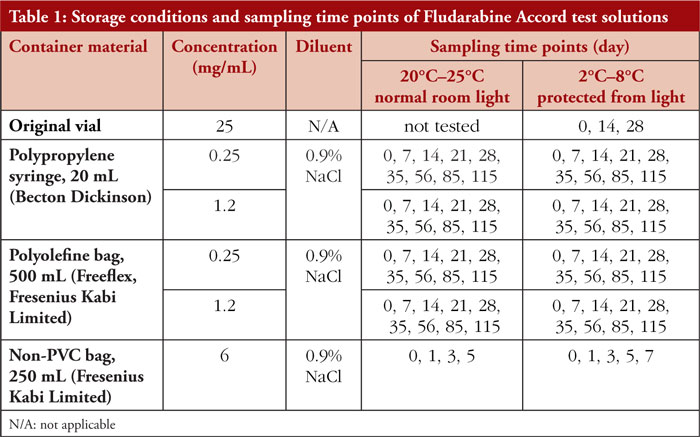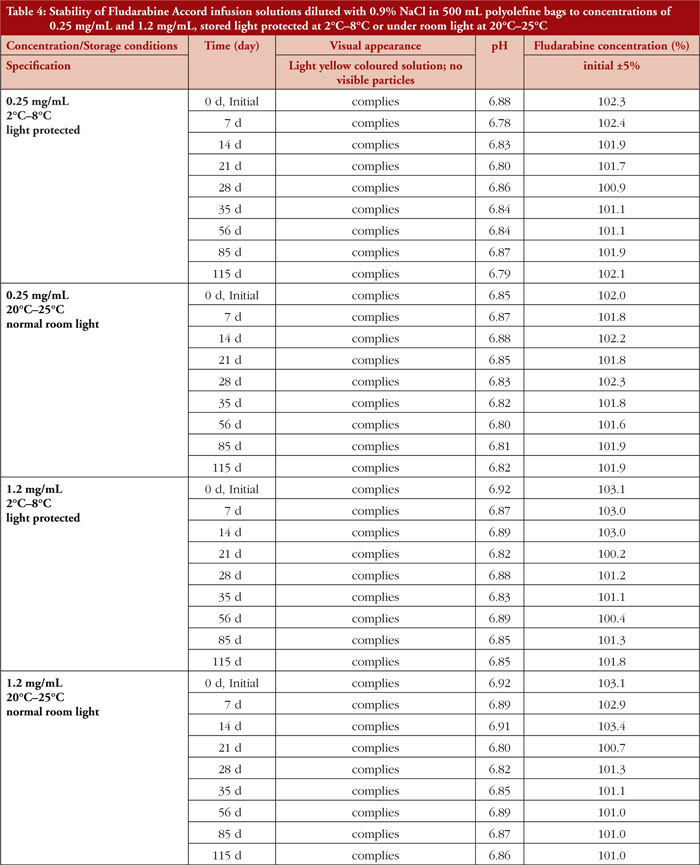Physicochemical stability of Fludarabine Accord in punctured original vials and after dilution with 0.9% sodium chloride solution
Published on 2024/09/11
Generics and Biosimilars Initiative Journal (GaBI Journal). 2024;13(2):127-28.
Author byline as per print journal: Irene Krämer, PhD; Frank Erdnuess, PhD; Judith Thiesen, PhD
|
Study objectives: To assess the physicochemical stability of fludarabine in punctured original vials and after dilution with 0.9% sodium chloride solution at three different concentrations (0.25 mg/mL, 1.2 mg/mL, 6.0 mg/mL) in commonly used infusion containers. |
Submitted: 12 February 2024; Revised: 18 April 2024; Accepted: 26 April 2024; Published online first: 6 May 2024
Introduction
Fludarabine phosphate, a fluorinated purine analogue, acts as antimetabolite inhibiting cell growth and inducing apoptosis. Effects on DNA, RNA, and protein synthesis contribute to the antineoplastic activity, with inhibition of DNA synthesis being the dominant factor.
The main indications are chronic lymphocytic leukaemia and conditioning therapy prior to blood stem cell transplantation. Fludarabine phosphate Accord 25 mg/mL is formulated with mannitol and disodium hydrogen phosphate dihydrate as excipients. According to the Summary of Product Characteristics (SmPC), physicochemical stability is given after dilution (fludarabine concentrations 0.2, 6 mg/mL) with 0.9% NaCl or 5% glucose infusion solution in non-PVC bags or glass bottles for 7 days when refrigerated or 5 days when stored at room temperature [1]. There are only two scientific publications available, reporting the physicochemical stability of another fludarabine-containing brand product (formulated without disodium hydrogen phosphate dihydrate) for 21 days after the first puncture [2] and 14 days [3] and 21 days [2] after dilution with 0.9% sodium chloride. Further experimental studies on the physicochemical stability of Fludarabine phosphate Accord 25 mg/mL after the first opening and diluted infusion solutions are necessary to enable valid shelf-life assignment in pharmacy-based cytotoxic preparation units.
Study objectives
To determine the physicochemical stability of Fludarabine Accord 25 mg/mL in punctured original vials and after dilution with 0.9% sodium chloride solution in 20 mL polypropylene (PP) syringes, 500 mL or 250 mL polyolefine (PO) bags to three different concentrations and under different storage conditions for a maximum period of 115 days.
Methods
Fludarabine test solutions were prepared under EU Class A conditions and in accordance with the principles of Good Manufacturing Practice. A total of six different test solutions were prepared using the European Medicines Agency (EMA) licensed Fludarabine Accord 25 mg/mL (batch number N11880). These test solutions were stored under refrigeration (2°C–8°C) with or without light protection, or at room temperature (20°C–25°C) under normal room light for up to 115 days. Samples were taken and analysed initially (Day 0) and at predetermined time points. Detailed information is provided in Table 1.
Physical stability was tested by pH measurements ( using a glass electrode calibrated with standard buffer solutions) and visual inspections under standard laboratory light for any change s in colour, clarity, and the presence of particulate matter.
Chemical stability was assessed via high-performance liquid chromatography (HPLC) assay, which has been validated for linearity of analytical response and acceptable precision. The assay was proven to be stability-indicating for non-specific degradation of the parent drug [4]. The acceptance criteria were defined as ±5% of label claim for undiluted solutions and as initial ±5% for diluted test solutions [4].
Results
Fludarabine Accord 25 mg/mL concentrate in punctured vials remained unchanged when stored refrigerated and protected from light for 28 days. Neither colour change, turbidity, nor visible particles were observed during visual inspection. Results of pH measurements showed only slight variations (maximum 0.05 units) during the observation period. In the HPLC chromatograms, no signs of chemical degradation of fludarabine were found. Slight variations of the fludarabine concentrations at different time points are related to the assay variability, as shown in Table 2.
Fludarabine test solutions, diluted with 0.9% NaCl solution to concentrations of 0.25 mg/mL and 1.2 mg/mL, remained physicochemically stable for up to 115 days. This stability was observed independent of the primary containers used (20 mL polypropylene syringes or 500 mL polyolefine bags) when stored light-protected at 2°C–8°C or under normal room light at 20°C–25°C. For detailed results, see Tables 3 and 4.
Fludarabine test solutions, diluted with 0.9% NaCl solution to a concentration of 6 mg/mL in non-PVC bags, remained physicochemically stable for up to 5 days at room temperature (20°C–25°C ) or 7 days under refrigeration (2°C–8°C ), as shown in Table 5.
Conclusion
The physicochemical stability of fludarabine concentrated and diluted solutions is established irrespective of the type of primary containers used, concentrations, temperature, and light conditions. Fludarabine Accord solution concentrate, 25 mg/mL, was proven to be physicochemical ly stable over the test period of 28 days after first opening in punctured original vials when stored light protected at 2°C–8°C. Hence, residues in the punctured original vials can be used cost-effectively for up to 28 days when stored refrigerated.
After dilution with 0.9% sodium chloride, fludarabine solutions (0.25 mg/mL, 1.2 mg/mL) were found to be physicochemically stable over the entire test period of 115 days, regardless of storage conditions (2°C–8°C, light protected; 20°C–25°C, room light) and primary containers used (polypropylene syringe, polyolefine bag). These results extend previously published data on physicochemical stability of another fludarabine-containing brand product [2, 3]. Thus, diluted infusion solutions with fludarabine concentrations between 0.25 mg/mL and 1.2 mg/mL may be prepared in advance by pharmacy-based cytotoxic preparation units and used over a period of 115 days.
Fludarabine 6 mg/mL test solutions stored in non-PVC bags remained unchanged over a test period of 7 days at refrigerated, light-protected storage and 5 days at room temperature without light protection. These results are consistent with the SmPC, which claims physical and chemical in-use stability for 0.2 mg/mL and 6 mg/mL solutions over 7 and 5 days, when stored in non-PVC bags at refrigerated or at room temperature, respectively.
Analysis was performed and documented by an accredited external laboratory. Results were carefully checked for plausibility and cautiously interpreted.
Funding sources
This study was funded by Accord Healthcare.
Competing interests: The authors Irene Krämer, Frank Erdnuess, and Judith Thiesen have no competing interest s to declare.
Provenance and peer review: Not commissioned; externally peer reviewed.
Authors
Professor Irene Krämer, PhD
Frank Erdnuess, PhD
Judith Thiesen, PhD
Department of Pharmacy, University Medical Center of the Johannes Gutenberg University Mainz, 1 Langenbeckstraße, DE-55131 Mainz, Germany
References
1. Accord Healthcare Limited. Summary of product characteristics for Fludarabine Phosphate Accord 25 mg/mL Concentrate for Solution for Injection or Infusion. Available from: https://cdn.accord-healthcare.com/ie/public/spc/spc_licence_pa2315-035-001pdf.pdf
2. Trittler R. New stability studies for fludarabine according to the European Pharmacopeia 7.0. Eur J Oncol Pharm. 2012;6(1):1-2.
3. Sewell GJ, Massimini M. Studies on the stability and compatibility of cytotoxic drug Infusions with the Tevadaptor device. Eur J Oncol Pharm. 2014; 8(3):26-30.
4. Accord Healthcare Limited. Data for HPLC assay and acceptance criteria on file; 13-05-2015.
|
Author for correspondence: Judith Thiesen, PhD, Department of Pharmacy, University Medical Center of the Johannes Gutenberg University Mainz, 1 Langenbeckstraße, DE-55131 Mainz, Germany |
Disclosure of Conflict of Interest Statement is available upon request.
Copyright © 2024 Pro Pharma Communications International
Permission granted to reproduce for personal and non-commercial use only. All other reproduction, copy or reprinting of all or part of any ‘Content’ found on this website is strictly prohibited without the prior consent of the publisher. Contact the publisher to obtain permission before redistributing.







